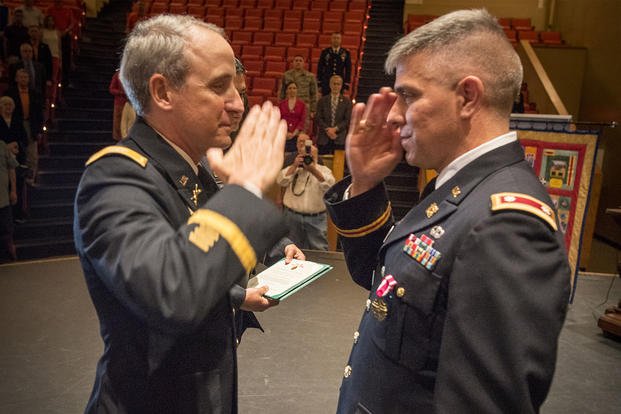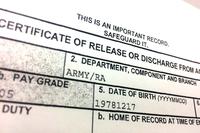The U.S. military is comprised of five organizations that instill pride in their members because of history, mission, capabilities and respect that has been earned in the service of the nation. A reflection of that pride is visible in the customs, courtesies and traditions of military service.
Customs
A custom is an established practice. Customs include positive actions -- things you do -- and taboos, or things you avoid. Some military customs are established by regulation, and you can be punished (even sent to jail) for disregarding them, while others are unwritten, but obeyed just the same.
The customs of the military services are their common law. These are a few:
- Never criticize your service or your leaders in public.
- Never go over the heads of superiors -- don't jump the chain of command.
- Never offer excuses.
- Never wear a superior's rank by saying something like, "The first sergeant wants this done now" when in fact, the first sergeant said no such thing. Speak with your own voice.
- Never turn and walk away to avoid giving the hand salute.
- Never run indoors or pretend you don't hear (while driving, for example) to avoid participating in reveille or retreat (raising or lowering of the U.S. flag).
- Never appear in uniform while under the influence of alcohol.
- If you don't know the answer to a superior's question, you will never go wrong with the response, "I don't know, sir (or ma'am), but I'll find out."
Courtesies
Courtesy among members of the Armed Forces is vital to maintain discipline. Military courtesy means good manners and politeness in dealing with other people. Courteous behavior provides a basis for developing good human relations. The distinction between civilian and military courtesy is that military courtesy was developed in a military atmosphere and has become an integral part of serving in uniform.
Military courtesy is not a one-way street. Enlisted personnel are expected to be courteous to officers, and officers are expected to return the courtesy. Mutual respect is a vital part of military courtesy. In the final analysis, military courtesy is the respect shown to each other by members of the same profession.
Addressing Military Members
Commissioned officers (and to a lesser extent, warrant officers) run the U.S. military. They are the top dogs. As such, they're always addressed politely, using sir or ma'am.
Tip: In the Marine Corps, Air Force and the first couple weeks of Coast Guard basic training, instructors also also addressed as sir or ma'am. Don't overuse these terms, though. In other words, don't say something like, "Sir, I have to go to the bathroom, sir." Otherwise, you're likely to hear a (very loud) speech about a sir sandwich.
Warning: If you're attending Army or Navy basic training, do not address your training instructor as sir or ma'am. This is guaranteed to result in a loud tirade about how they work for a living.
In the Army and Navy, drill instructors are addressed by using their military rank and often their last name -- for example, Chief or Staff Sergeant Smith. In Marine Corps basic training, do not use personal pronouns such as "you," "I" or "we." These pronouns will send your Marine Corps basic training instructor into an absolute tizzy. Instead, speak in the third person: "Does the drill instructor want this recruit to inform the other recruits of his instructions?"
Military Salutes
The salute isn't simply an honor exchanged; it's a privileged gesture of respect and trust among military members. Remember: The salute is not only prescribed by regulation, but is also recognition of each other's commitment, abilities and professionalism.
The salute is widely misunderstood outside the military. Some consider it to be a gesture of servility since the junior extends a salute to the senior, but this interpretation isn't true at all. The salute is an expression that recognizes each other as a member of the profession of arms -- that they have made a personal commitment of self-sacrifice to preserve the American way of life. The fact that the junior extends the greeting first is merely a point of etiquette -- a salute extended or returned makes the same statement.
Tip: The way you salute says a lot about you as a military member. A proud, smart salute shows pride in yourself and your unit and that you're confident in your abilities as a soldier. A sloppy salute can mean that you're ashamed of your unit, lack confidence or, at the very least, haven't learned how to salute correctly.
You'll get plenty of practice saluting in basic training, but it wouldn't hurt to practice in front of a mirror several times before you leave so that you can do it correctly automatically.
All military enlisted personnel in uniform are required to salute when they meet and recognize a commissioned or warrant officer, except when it is inappropriate or impractical (for example, if you're carrying something using both hands). A salute also is rendered:
- When the United States national anthem, "To the Color," "Hail to the Chief" or foreign national anthems are played
- To uncased national color outdoors
- On ceremonial occasions, such as changes of command or funerals
- At reveille and retreat ceremonies, during the raising or lowering of the flag
- When pledging allegiance to the U.S. flag outdoors
- When turning over control of formations
- When rendering reports
- On the stern of a ship when arriving or departing from the ship
- To officers of friendly foreign countries
Salutes are not required when:
- Indoors, unless reporting to an officer or when on duty as a guard
- When you're in a combat zone
- When you're a prisoner
- Saluting is obviously inappropriate
- Either the senior or the subordinate is wearing civilian clothes. In any case not covered by specific instructions, render the salute.
Other Courtesies
Military courtesy shows respect and reflects self-discipline. While some of these courtesies seem to wane after basic, they're strictly adhered to during military basic training:
- When talking to an officer, stand at attention until ordered otherwise.
- When you're dismissed or when the officer departs, come to attention and salute.
- When speaking to or being addressed by a noncommissioned officer of superior rank, stand at parade rest until ordered otherwise.
- When an officer enters a room, the first enlisted person to recognize the officer calls personnel in the room to attention but does not salute. A salute indoors is rendered only when reporting to an officer.
- Walk on the left of and slightly behind an officer or NCO of superior rank.
- When entering or exiting a vehicle or boat, the junior ranking military member is the first to enter, and the senior in rank is the first to exit.
- The first person who sees an officer enter a dining facility gives the order, "At ease," unless a more senior officer already is present. Many units also extend this courtesy to senior NCOs.
- When you hear the command, "At ease," in a dining facility, remain seated and silent and continue eating unless directed otherwise.
From Basic Training for Dummies, copyright © 2011 by Wiley Publishing, Inc., Hoboken, New Jersey. Used by arrangement with John Wiley & Sons, Inc.
Interested in Joining the Military?
We can put you in touch with recruiters from the different military branches. Learn about the benefits of serving your country, paying for school, military career paths and more: sign up now and hear from a recruiter near you.












